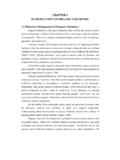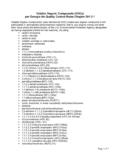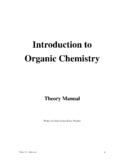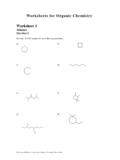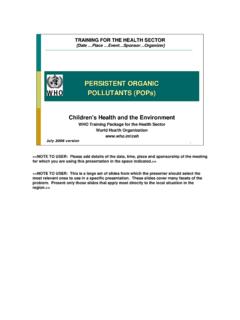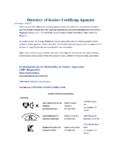Transcription of Enthalpies of Vaporization of Organic and …
1 Enthalpies of Vaporization of Organic and organometallic Compounds, 1880 2002. James S. Chickosa . Department of Chemistry, University of Missouri-St. Louis, St. Louis, Missouri 63121. William E. Acree, . Department of Chemistry, University of North Texas, Denton, Texas 76203. Received 17 June 2002; accepted 17 October 2002; published 21 April 2003 . A compendium of Vaporization Enthalpies published within the period 1910 2002 is reported. A brief review of temperature adjustments of Vaporization Enthalpies from temperature of measurement to the standard reference temperature, K, is included as are recently suggested reference materials. Vaporization Enthalpies are included for Organic , organo-metallic, and a few inorganic compounds. This compendium is the third in a series focusing on phase change Enthalpies . Previous compendia focused on fusion and sublimation Enthalpies . Sufficient data are presently available for many compounds that thermodynamic cycles can be constructed to evaluate the reliability of the measure- ments.
2 A protocol for doing so is described. 2003 American Institute of Physics. DOI: . Key words: compendium; Enthalpies of condensation; evaporation; Organic compounds; Vaporization enthalpy. Contents inorganic compounds, 1880 2002.. 820. 1. Introduction.. 519 8. References to Tables 6 and 7.. 853. 2. Reference Materials for Vaporization Enthalpy Measurements.. 520 List of Figures 3. Heat Capacity Adjustments.. 520 1. A thermodynamic cycle for adjusting Vaporization 4. Group Additivity Values for C p l ( K) Enthalpies to T .. 521. 2. A hypothetical molecule illustrating the different Estimations.. 521. hydrocarbon groups in estimating C p .. 523. 5. A Thermochemical Cycle: Sublimation, Vaporization , and Fusion Enthalpies .. 523. 6. Estimation of Vaporization Enthalpies .. 525 1. Introduction 7. Vaporization Enthalpy Compendium.. 525. 8. Acknowledgment.. 878 Vaporization Enthalpies are important thermodynamic 9. References for Introductory Material.
3 878 properties of the condensed phase. Vaporization Enthalpies are used frequently in adjusting Enthalpies of formation of List of Tables liquids to the standard state and in evaluating environmental 1. Recommended reference standards for transport ,2 To the chemical engineer, the magni- Vaporization enthalpy measurements.. 520 tude of this property needs to be taken into consideration in 2. Group values l and c for estimating designing equipment for chemical processing and synthesis. C p l ( K) and C p c ( K).. 522 Thus Vaporization enthalpy data are of interest at a variety of 3. Some estimations of C p l ( K) and temperatures. As a consequence, there is a wealth of infor- C p c ( K) using group values.. 524 mation in the literature that covers measurements over a 4. A comparison of experimental sublimation broad range of temperatures. The data covered by this com- Enthalpies and those calculated using Eq. 6 .. 525 pendium include as much of the spectrum as was available to 5.
4 A list of acronyms used in Tables 6 and 7.. 526 us. 6. Enthalpies of Vaporization of Organic compounds, Our interest in Vaporization Enthalpies goes back nearly 1880 2002.. 527 two decades. Our primary focus in measuring Vaporization 7. Enthalpies of Vaporization of organometallic and Enthalpies was as a means of adjusting Enthalpies of forma- tion of liquids to the standard state and in conjunction with a . fusion Enthalpies to adjust solids in a similar Since Author to whom correspondence should be addressed; electronic mail: then we have focused our attention on their estimation,4 and b . Electronic mail: In parallel studies, compilations of available 2003 American Institute of Physics. sublimation and fusion Enthalpies were also ,7 A. 0047-2689 2003 32 2 519 360 $ 519 J. Phys. Chem. Ref. Data, Vol. 32, No. 2, 2003. 520 J. S. CHICKOS AND W. E. ACREE, JR. TABLE 1. Recommended reference standards for Vaporization enthalpy measurements Substance T/K range Vapor pressure range/Pa vapH m K kJ mol 1 Classification a,d C3 H8 O 1-propanol 333 378 20 E 3 135 E 3 Primary C5 H12 pentaneb,d 269 315 E 4 E 5 Primary C6 F6 hexafluorobenzenea,d 290 377 E 3 E 5 Primary C6 H6 benzenea,c,d 286 383 E 3 E 5 Primary C6 H14 hexaneb,d 286 343 E 4 E 5 Primary C7 H16 heptaneb,d 299 372 E 3 E 5 Primary C8 H18 octaneb,d 326 400 E 3 E 5 Primary C9 H20 nonaneb,d 344 425 E 3 E 5 Primary C10H8 naphthalened 353 434 E 3 E 4 Secondary C10H22 decaneb,d 268 348 E 1 E 3 Primary C11H24 undecaneb,d 294 382 E 1 E 3 Primary C12H26 dodecaneb,d 313 403 E 1 E 3 Primary C13H28 tridecaneb,d 323 402 E 1 E 3 Primary C14H30 tetradecaneb,d 344 422 E 1 E 3 Primary C16H32 hexadecaneb,d 364 452 E 1 E 3 Primary C18H38 octadecaneb,d 312 590 E 1 E 5 Primary C20H42 eicosaneb,d 344 380 E 1 E 0 Primary H2 O waterd 273 373 E 1 E 5 Primary a Reference 12.
5 B Reference 13. c Cancer suspect agent. d Reference 5. reasonably exhaustive version of these databases covering in Table 1. The temperature range, the corresponding vapor the literature to the present has recently been published and pressures, and the recommended molar Vaporization enthal- is also available on line at pies at T K are also included in the table. Some of chemistry/. Combined with fusion and sublimation enthalp- these reference materials are solids at T K and ies appropriately adjusted to T K, Vaporization en- therefore the Vaporization Enthalpies are hypothetical values. thalpies vapH m ( K), complete a thermochemical The reader should consult the literature cited at the bottom of cycle that can be used to assess the quality of the available the table to obtain the Vaporization enthalpy at the tempera- data. Application of this thermochemical cycle is illustrated ture of interest. below. A goal of the present contribution has been to provide an exhaustive coverage of the literature from about 1880 to 2002; regrettably however, this compilation is probably still 3.
6 Heat Capacity Adjustments incomplete. Vaporization Enthalpies , like their sublimation counter- 2. Reference Materials for Vaporization parts, are measurements based on mass transport and as such Enthalpy Measurements are directly or indirectly dependent upon vapor pressure. The vapor pressure of different liquids at a given temperature can Calibration is a fundamental requirement in every thermo- vary many orders of magnitude. In order to obtain a reason- chemical measurement of Vaporization enthalpy. Regardless able amount of mass transport, it is frequently necessary to of which technique is used, the measurement ultimately de- conduct these measurements at temperatures that differ sub- pends either directly or indirectly on vapor pressure. Vapor stantially from the standard reference temperature, K. pressures of liquids vary over many orders of magnitude. An The actual temperature of measurement depends on the sen- experimental technique calibrated with a standard in one sitivity of the instrument or apparatus and the properties of pressure or temperature regime does not in itself guarantee the substance of interest.
7 Vaporization enthalpy measure- the same accuracy in another. Substantial variations in vapor- ments are often conducted as a function of temperature. ization enthalpy are revealed in the tables that follow. This The magnitude of the Vaporization enthalpy is dependent variance clearly establishes the importance of documenting on temperature. Figure 1 and Eqs. 1 and 2 illustrate the the accuracy of the measurements through the use of appro- origin of this temperature dependence in terms of a thermo- priate reference materials that approximate the temperature dynamic cycle. If the heat capacities of the liquid and gas and pressure regimes of the measurements of interest. phase are known, C p l and C p g , respectively, then the vapor- A series of compounds have been recently proposed as ization enthalpy at T K can be related to the experi- reference materials for Vaporization These have mental measurements by using Eq. 1 . This equation, gen- been classified as primary, secondary, or tertiary reference erally referred to as Kirchhoff's equation, can be used to materials, on the basis of various criteria.
8 The materials clas- adjust sublimation enthalpy measurements to any reference sified as primary and secondary reference materials are listed temperature. The term T m represents either the temperature J. Phys. Chem. Ref. Data, Vol. 32, No. 2, 2003. Enthalpies OF Vaporization 521. temperature. In some cases experimental data have been used for C p l and in other cases both C p l and C p g have been esti- mated. The reader is encouraged to refer to the original lit- erature for details. In an effort to provide some assistance to the reader in this regard, a brief discussion of one of the group additivity methods that are available for estimating the heat capacity of liquids is included below. This is followed by an illustration of how this value can be used in conjunc- tion with Eq. 3 to provide temperature adjustments. 4. Group Additivity Values for FIG. 1. A thermodynamic cycle for adjusting Vaporization Enthalpies to T C p l K Estimations K.
9 Tables 2A and 2B lists a set of group values that can be of measurement for calorimetric measurements or the mean used in estimations of C p l ( K). The groups and their temperature of measurement for experiments conducted corresponding values are identified by italics. A hypothetical molecule is given in Fig. 2 that identifies each hydrocarbon vapH m K vapH m T m group. The functional groups listed in Table 2B are self ex- Tm C p l C p g dT 1 . planatory. The R terms in this table represent variable groups and are not included in the value. Values in brackets should be considered as tentative assignments. The use of these vapH m K vapH m T m group values is illustrated with the examples in Table 3. Es- timations of C p c ( K) for these compounds follow the C p l C p g T m 2 . same protocol. over narrow ranges of temperature. Treating the heat capaci- Groups are defined on the basis of their substitution and ties of the two phases as independent of temperature and hybridization patterns.
10 These groups are further subdivided integrating Eq. 1 results in Eq. 2 . Since the magnitude of into cyclic, acyclic and aromatic categories. The estimation the heat capacity of the gas phase is usually smaller than that of C p l ( K) for propionic acid illustrates how directly of the liquid phase l , Vaporization Enthalpies increase with C p values can be estimated. Identification of the appropriate decreasing temperature. group is important. Although not shown in Table 3, the same Experimental heat capacities for many liquids at T protocol is used for estimating C p c ( K). Estimation of K are Experimental gas phase heat ca- the heat capacity of piperadine is similar. In this case it is pacities for compounds that are liquids at T K are important to use the appropriate cyclic group. Once the unavailable and generally need to be estimated. Gas phase proper groups are identified, the estimation is direct. Di-t- heat capacities can be calculated from statistical mechanics butyl ether is estimated in a similar fashion.

